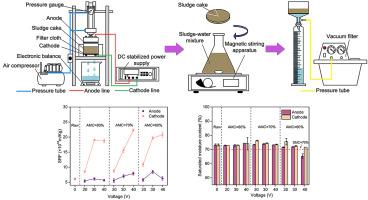Environmental Research ( IF 7.7 ) Pub Date : 2020-08-05 , DOI: 10.1016/j.envres.2020.110011 Li Sha 1 , Xiaoyan Yu 2 , Yuxin Zhang 1 , Qingqing Jiang 1 , Xingxin Liu 1 , Zhangxiang Wu 1 , Shuting Zhang 1

|
Since the effect of electro-dewatering (EDW) on sludge water holding capacity was unknown, tests were conducted in this study to investigate the water holding capacity of EDW sludge and the potential mechanism related to the sludge physicochemical characteristics, EPS properties and sludge structure. Sludge was dewatered to the average moisture content (AMC) of 80%, 70% and 60% with different applied voltages at 20, 30 and 40V in EDW, respectively. Then the dewatered sludge near the anode and cathode were rewatered. The variation of sludge water holding capacity in EDW process was evaluated in terms of filterability and saturated moisture content (SMC), and the filterability was assessed by the specific resistance to filtration (SRF) of rewatered sludge. The results indicated that SRF of rewatered sludge near the cathode increased greatly. The proteins/polysaccharides (PN/PS) of loosely bound extracellular polymeric substances (LB-EPS) was significantly positively correlated with SRF (r = 0.891, p < 0.01). Moreover, the exposure of hydrophobic sites or groups in PN near the cathode improved the surface hydrophobicity of sludge, which reduced the filterability. In addition, higher voltage could destroy the sludge structure near the anode at the later stage of EDW process, leading to the decrease of SRF and SMC. These results expanded the knowledge about changes in sludge properties and water holding capacity during EDW process.
中文翻译:

电脱水过程污泥持水量变化的研究。
由于电脱水(EDW)对污泥持水量的影响尚不清楚,因此在本研究中进行了测试,以研究EDW污泥的持水量以及与污泥理化特性,EPS特性和污泥结构相关的潜在机理。在EDW中分别施加20、30和40V的不同电压,将污泥脱水至平均水分含量(AMC)为80%,70%和60%。然后将阳极和阴极附近的脱水污泥重新脱水。EDW工艺中污泥持水能力的变化通过可过滤性和饱和水分含量(SMC)进行评估,可过滤性通过再水化污泥的比过滤抗性(SRF)进行评估。结果表明,阴极附近再水污泥的SRF大大增加。松散结合的细胞外聚合物质(LB-EPS)的蛋白质/多糖(PN / PS)与SRF呈显着正相关(r = 0.891,p <0.01)。此外,阴极附近PN中疏水位点或基团的暴露改善了污泥的表面疏水性,从而降低了可过滤性。此外,较高的电压可能会在EDW工艺的后期破坏阳极附近的污泥结构,从而导致SRF和SMC降低。这些结果扩展了有关EDW过程中污泥性质和持水量变化的知识。阴极附近PN中疏水位点或基团的暴露改善了污泥的表面疏水性,从而降低了可过滤性。此外,较高的电压可能会在EDW工艺的后期破坏阳极附近的污泥结构,从而导致SRF和SMC降低。这些结果扩展了有关EDW过程中污泥性质和持水量变化的知识。阴极附近PN中疏水位点或基团的暴露改善了污泥的表面疏水性,从而降低了可过滤性。此外,较高的电压可能会在EDW工艺的后期破坏阳极附近的污泥结构,从而导致SRF和SMC降低。这些结果扩展了有关EDW过程中污泥性质和持水量变化的知识。











































 京公网安备 11010802027423号
京公网安备 11010802027423号